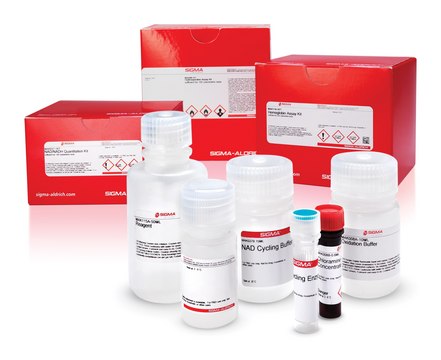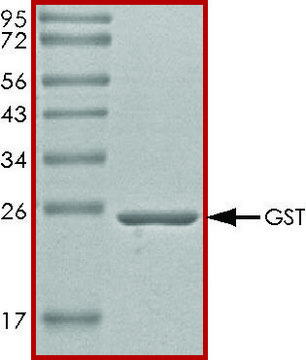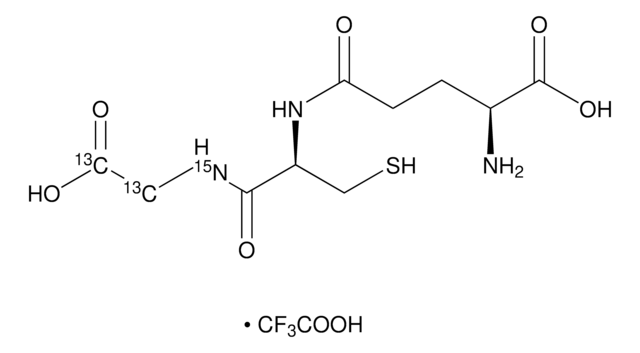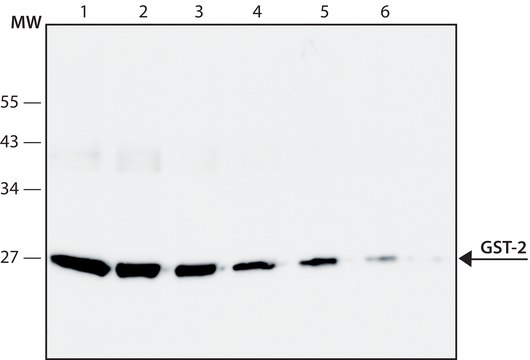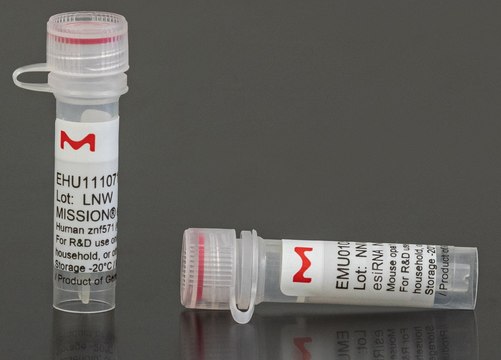Key Documents
Safety Information
G5663
Glutathione S-Transferase from E. coli
recombinant, expressed in E. coli, buffered aqueous solution
Synonym(s):
Glutathione S-alkenetransferase, Glutathione S-alkyltransferase, Glutathione S-aralkyltransferase, Glutathione S-aryltransferase, Glutathione S-epoxidetransferase, RX: Glutathione R-transferase
Select a Size
Select a Size
About This Item
Recommended Products
recombinant
expressed in E. coli
grade
Molecular Biology
form
buffered aqueous solution
mol wt
26 kDa
concentration
>0.1 mg/mL
>1 unit/mL
UniProt accession no.
shipped in
wet ice
storage temp.
2-8°C
Gene Information
human ... GSTM1(2944)
1 of 4
This Item | EHU025551 | EHU010991 | EHU040421 |
|---|---|---|---|
| esiRNA cDNA target sequence GACCAGGTGGTCCTGTCCTACGGGGGCCTGCGCGGGGCCGTGGCCTTTGCCCTGGTGGTGCTTCTGGATGGAGACAAGGTCAAGGAGAAGAACCTGTTCGTCAGCACCACCATCATCGTAGTGTTCTTCACCGTCATCTTCCAGGGCCTGACCATCAAGCCTCTGGTGCAGTGGCTGAAGGTGAAGAGGAGCGAGCACCGGGAACCTCGGCTCAACGAGAAGCTGCACGGGCGCGCTTTCGACCACATCCTCTCGGCCATCGAGGACATATCCGGACAGATCGGGCACAATTATCTCAGAGACAAGTGGTCCCACTTCGACAGGAAGTTCCTCAGCAGGGTCCTCATGAGACGGTCGGCCCAGAAGTCTCGAGACCGGATCCTGAATGTCTTCCACGAGCTG | esiRNA cDNA target sequence CACCACTGGAACTGGACCTTCGTCATCAGCACCCTGCTCTTCTGCCTCATCGCCCGCGTGCTGGGGGTGCTGGGCCTGACCTGGTTCATCAACAAGTTCCGTATCGTGAAGCTGACCCCCAAGGACCAGTTCATCATCGCCTATGGGGGCCTGCGAGGGGCCATCGCCTTCTCTCTGGGCTACCTCCTGGACAAGAAGCACTTCCCCATGTGTGACCTGTTCCTCACTGCCATCATCACTGTCATCTTCTTCACCGTCTTTGTGCAGGGCATGACCATTCGGCCCCTGGTAGACCTGTTGGCTGTGAAGAAAAAGCAAGAGACGAAGCGCTCCATCAACGAAGAGATCCACACACAGTTCCTGGACCACCTTCTGACAGGCATCGAAGACATCTGTGGCCACTACGGTCACCACCACTG | esiRNA cDNA target sequence TTCTCCTTTCCTGGGGAACTTCTGATGAGGATGTTACAGATGCTGGTCTTACCACTTATCATCTCCAGTCTTGTCACAGGAATGGCGGCGCTAGATAGTAAGGCATCAGGGAAGATGGGAATGCGAGCTGTAGTCTATTATATGACTACCACCATCATTGCTGTGGTGATTGGCATAATCATTGTCATCATCATCCATCCTGGGAAGGGCACAAAGGAAAACATGCACAGAGAAGGCAAAATTGTACGAGTGACAGCTGCAGATGCCTTCCTGGACTTGATCAGGAACATGTTCCCTCCAAATCTGGTAGAAGCCTGCTTTAAACAGTTTAAAACCAACTATGAGAAGAGAAGCTTTAAAGTGCCCATCCAGGCCAACGAAACGCTTGTGGGTGCTGTGATAAACAATGTGTCTGAGGCCATGGAGACTCT | esiRNA cDNA target sequence TGGCAAGATCAACAGCGTAGAGCAGAATGATATGCTACGGAAGGTAACATTCGATCCAGAAGTATTTTTCAACATTCTTCTGCCTCCAATTATTTTTCATGCTGGATACAGCTTAAAGAAGAGACACTTTTTCAGAAATCTTGGATCTATACTGGCCTATGCCTTCTTGGGGACTGCTGTTTCATGCTTCATTATTGGAAATCTCATGTATGGTGTGGTGAAGCTCATGAAGATTATGGGACAGCTCTCAGATAAATTTTACTACACAGATTGTCTCTTTTTTGGAGCAATCATCTCTGCCACTGACCCAGTGACTGTGCTGGCGATATTTAATGAATTGCATGCAGACGTGGATCTTTACGCACTTCTTTTTGGAGAGAGCGTCCTAAATGATGCTGTTGCCATTGTACTGTCCTCGTCTATTGTTGCCTACCAGCCAGCGGGACTGAACACTCACGCCTTTGA |
| product line MISSION® | product line MISSION® | product line MISSION® | product line MISSION® |
| Gene Information human ... SLC9A3(6550), SLC9A3(6550) | Gene Information human ... SLC9A1(6548), SLC9A1(6548) | Gene Information human ... SLC1A3(6507), SLC1A3(6507) | Gene Information human ... SLC9A7(84679), SLC9A7(84679) |
| Ensembl | human accession no. | Ensembl | human accession no. | Ensembl | human accession no. | Ensembl | human accession no. |
| NCBI accession no. | NCBI accession no. | NCBI accession no. | NCBI accession no. |
| form lyophilized powder | form lyophilized powder | form lyophilized powder | form lyophilized powder |
General description
Specificity
second substrate.
In ELISA, 0.5 μg of recombinant glutathione S-transferase is the minimum detectable level of enzyme with an anti-glutatione S-transferase, alkaline phosphatase conjugate.
In immunoblot, 50 ng of recombinant GST is the minimum detectable level of enzyme with an anti-glutathione S-transferase, alkaline phosphatase conjugate.
Application
Biochem/physiol Actions
Warning
Unit Definition
Physical form
related product
Storage Class Code
12 - Non Combustible Liquids
WGK
nwg
Flash Point(F)
Not applicable
Flash Point(C)
Not applicable
Regulatory Information
Choose from one of the most recent versions:
Already Own This Product?
Find documentation for the products that you have recently purchased in the Document Library.
Our team of scientists has experience in all areas of research including Life Science, Material Science, Chemical Synthesis, Chromatography, Analytical and many others.
Contact Technical Service


